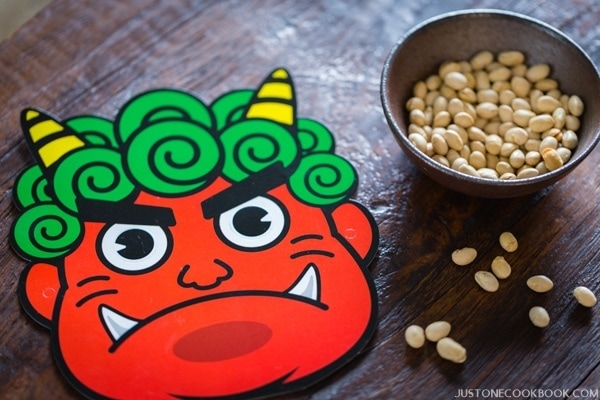Masked demons pelted with roasted soybeans as they are chased away! What better way to scare away the ills of winter and welcome the freshness of spring? One of the anticipated festivals in Japan – Setsubun!
It may not feel like spring to you in early February, but on February 3rd, Japanese celebrate the day before the beginning of spring during an annual festival called Setsubun (節分).
Like New Year’s Eve, this Japanese festival is about leaving worries behind and making a new start. But the metaphor during Setsubun takes on a more visually satisfying element of both children and adults, happily driving away demons by pummeling them with beans. This demon may be a family member, school principal, a colleague, or just about anyone daring enough to wear the Oni (demon) mask.
Origin of Setsubun Festival
Prior to 1873, the Japanese New Year followed the lunar calendar. But with the adoption of the Gregorian calendar during the Meiji period, the importance of the new year shifted from late January/mid-February of the lunar calendar to January 1st. Even though the official date of the Japanese New Year changed, Setsubun remained a widely celebrated day to mark the changing of the seasons.
The origin of Setsubun is closely tied to Chinese customs and beliefs during the Lunar New Year, when the spirit world intersects with our world, allowing spirits to cross our paths and even enter our homes. It is believed some of these spirits bring illnesses and bad luck to a family, and must be purged from the home before the new year begins. To ward off these evil spirits on Setsubun, a ritual dating back to the Muromachi period (1337-1573) is practiced with fervor. This ritual is called Mamemaki, and yes, this is where your bean throwing skills come in to play!

“Oni wa soto. Fuku wa uchi.”
Mamemaki – Throwing Roasted Soybeans on Setsubun
On Setsubun, when evil spirits roam the streets and knock on your door, this is not a time to hand out Halloween candy. Fill a Japanese wooden cup called a masu with fortune beans (roasted soybeans). With the cup in your strong arm, bend your knees into a ready position. Ask the bravest family member to open the door on your count. 1, 2, 3, go! The moment that door rushes open, pushed by the force of a winter gale, with an evil spirit riding on that invisible wave, that’s when you give it a mouthful of beans. Toss that cup of roasted soybeans out through the door while screaming, “Oni wa soto! Fuku wa uchi” (“Demons Out! Good Fortunes In! 鬼は外! 福は内!). As you lunge forward into that demon-tainted wind, the beans clearing your path to safety, catch the side of the door and slam it shut! Fall to the floor, with you back securing the door, and whisper under an exhausted and exhilarated breath, “Oni wa soto. Fuku wa uchi.”
Many Japanese on Setsubun prefer instead to have a more tangible target for Mamemaki, to make certain they hit their mark and ward off bad luck for the coming season. This is where a parent courageously puts on the Oni (demon) mask and takes one for the team. Armed with fortune beans and an eagerness to break cabin fever, both spouse and children let the beans fly at the fleeing demon, chanting “Demons Out! Good Fortunes In!”
Roasted soybeans actually serve two purposes on Setsubun. They are of course excellent for thwarting demons, but just as good for snacking on after all that demon-thwarting activity. After mamemaki is successfully over, the Japanese household gathers and eats the same number of fortune beans as their age. It’s for good luck, as are all the traditional foods eaten on this special night.
Delicious Food for Setsubun Festival
Roasted Soybeans
Roasted soybeans are customary on Setsubun, so you can find them sold everywhere from supermarkets to convenient stores to street stalls. They have a sweet, nutty flavor with a satisfying crunch, perfect for throwing at demons or popping into your mouth.
Eho-Maki – Sushi Rolls for Setsubun
The primary food on Setsubun is a sushi roll called Eho-maki (恵方巻). This special sushi roll is made with seven fillings, representing the Seven Deities of Good Fortune called Shichifukujin. The type of ingredients are not as important as the number. You can choose your favorite seven sushi roll ingredients, and roll them up tight to lock in the elements of good health, happiness, and prosperity. It is also very important not to cut the eho-maki sushi roll for this same reason. Cutting the sushi roll, as would normally be done on any other day, will slice into your good fortune.
There is one more essential practice to get this right. Eho (恵方) means “lucky direction”. So this special sushi roll is literally a Lucky Direction Sushi Roll. That means if you don’t eat it facing the lucky direction, don’t count on dreams coming true this spring. With eho-maki in both hands, face South by Southeast into the auspicious direction of 2018, and eat the entire sushi roll while keeping completely silent, pondering the season passed, wishing for good health and happiness in the spring, and enjoying every bite of your delicious Setsubun festival favorite – Eho-maki.

You can get a “packaged setsubun set” at Japanese grocery stores.
Experience Setsubun in Japan
Setsubun isn’t only a family affair. If you are lucky enough to be in Japan on a February 3rd, you can find Setsubun events throughout the country. While Setsubun festival is not a public holiday in Japan, it may feel like it at many Buddhist temples and Shinto shrines where dozens and sometime even thousands of “bean-throwers” gather to drive the demons away and welcome good luck in the spring. One of the largest Setsubun Festivals in Japan is held at Zojoji Temple in Tokyo. This is where you will find famous entertainers, politicians, and sumo wrestlers taking part in the Setsubun festivities.
If you’re not in Japan, you can still enjoy elements of Setsubun with your family or friends. Buy some roasted soybeans to snack on and practice your throwing skills (you can even buy Oni masks online!). Make a sushi roll and eat up that good luck. It’s a fun Japanese festival to experience. You can even turn that sushi party you were planning on hosting into an Eho-Maki party, and incorporate Setsubun activities into the night.

Originally from Penang, Malaysia, Reese lives in Minnesota with her husband and their baby boy. She previously ran an Asian spice shop, and also worked on UNESCO Heritage projects in Penang in the areas of performing arts, history, and arts education. Reese loves spending time with her family, listening to podcasts, and reading up on art & design. And of course dreaming of another trip to Japan to hike mountain trails and eat her favorite street food Okonomiyaki. More from Reese →
The post Setsubun: The Japanese Bean Throwing Festival appeared first on Just One Cookbook.
Resource : http://ift.tt/2vMxpFu






No comments:
Post a Comment